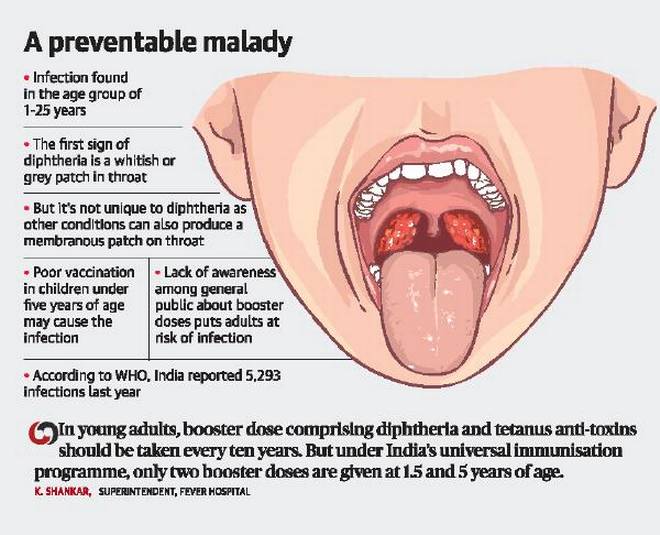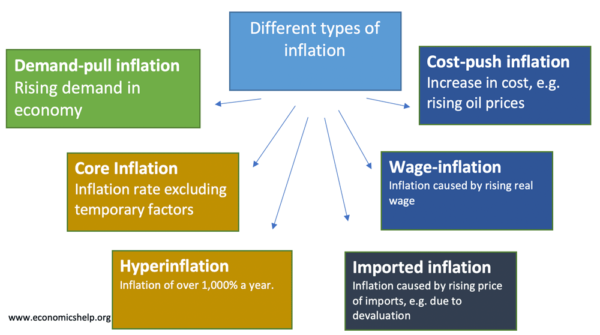UPSC IAS Exam Current Affairs Notes & MCQs
TABLE OF CONTENTS
2. HOW ASIAN DESERT DUST ENHANCES INDIAN SUMMER MONSOON
Effect of Inflation on the Economy
1. DIPHTHERIA
- Diphtheria usually begins with angina (a type of chest pain) and tonsilitis symptoms, sore throat, and mild fever.
- The diphtheria toxin causes inflammation of heart muscle (myocarditis) and this can lead to death if not treated with diptheria antitoxin and proper antibiotics.
- Formation of white-grey pseudomembrane over parts of the throat (pharynx) , voice box (larynx) and tonsils and swollen bull neck are considered stereotypical, although they may not show up in some cases.

Vaccine preventable
- Diphtheria is a vaccine preventable disease – the toxoid vaccine elicits an immune response against the toxin which is encoded by a tox gene of the pathogen. Sometimes, spurts of diphtheria outbreaks occur in unvaccinated or partially vaccinated communities.
- There is an increasing trend in the number of cases of diphtheria globally, as the number of cases in 2018 (16,651) was double the 1996–2017 average (8,105). Relevant to India is the statistic that 50% of the cases that came up in 2018 were in India.
- The researchers study the variations (or mutations) in the tox gene, which is responsible for producing the diphtheria toxin – which is the main target of the vaccinations.
Q. DPT vaccine stands for
(a) diphtheria, polio & tuberculosis
(b) diphtheria, pertussis & tuberculosis
(c) diphtheria, polio & tetanus
(d) diphtheria, pertussis, and tetanus
Ans. d
2. HOW ASIAN DESERT DUST ENHANCES INDIAN SUMMER MONSOON
- Dust swarms can influence moisture transport, increase precipitation, rainfall.
- Dust swarms from the desert when lifted by strong winds can absorb solar radiation and become hot.
- This can cause heating of the atmosphere, change the air pressure, wind circulation patterns, influence moisture transport and increase precipitation and rainfall.
- A strong monsoon can also transport air to West Asia and again pick up a lot of dust.
- The dust aerosols from deserts in West China such as the Taklamakan desert and the Gobi Desert can be transported eastward to eastern China and can influence the East Asia summer monsoon. And in the southwest United States, we have some small deserts that influence the North African monsoon.
Why study dust?
- Many studies have shown that the dust emission scheme is extremely sensitive to climate change and the team writes that understanding these mechanisms and effects of dust will help understand our monsoon systems in the face of global climate change.
3. INFLATION
On the last day of the financial year 2020-21, the Finance Ministry announced that the inflation target for the five years between April 2021 and March 2026 will remain unchanged at 4%, with an upper tolerance level of 6% and a lower tolerance level of 2%. This is the retail inflation target that will drive the country’s monetary policy framework and influence its decision to raise, hold or lower interest rates.
What is Inflation?
- Inflation can be defined as a calculated surge in the average prices of goods and services for a longer duration in the economy.
- It is a macro concept, wherein the effect of inflation is seen over a large basket of goods.
- The ultimate effect of inflation is that the value of money is reduced i.e., the purchasing power of money is reduced.

What causes inflation?
- There are three main causes of inflation: demand-pull inflation, cost-push inflation, and built-in inflation.
- Demand-pull inflation refers to situations where there are not enough products or services being produced to keep up with supply, causing their prices to increase.
- Cost-push inflation, on the other hand, occurs when the cost of producing products and services rises, forcing businesses to raise their prices.
- Lastly, built-in inflation—sometimes referred to as a “wage-price spiral”—occurs when workers demand higher wages to keep up with rising living costs. This in turn causes businesses to raise their prices in order to offset their rising wage costs, leading to a self-reinforcing loop of wage and price increases.
Is inflation good or bad?
- Too much inflation is generally considered bad for an economy, while too little inflation is also considered harmful. Many economists advocate for a middle-ground of low to moderate inflation, of around 2% per year.
- Generally speaking, higher inflation harms savers because it erodes the purchasing power of the money they have saved. However, it can benefit borrowers because the inflation-adjusted value of their outstanding debts shrinks over time.
Measurement of Inflation
- Wholesale Price Index (WPI) – It is estimated by the Ministry of Commerce & Industry and measured on a monthly basis.
- Consumer Price Index (CPI) – It is calculated by taking price changes for each item in the predetermined lot of goods and averaging them.
- Producer Price Index – It is a measure of the average change in the selling prices over time received by domestic producers for their output.
- Commodity Price Indices – It is a fixed-weight index or (weighted) average of selected commodity prices, which may be based on spot or futures price
- Core Price Index – It measures the prices paid by consumers for goods and services without the volatility caused by movements in food and energy prices. It is a way to measure the underlying inflation trends.
- GDP deflator – It is a measure of general price inflation.
Effect of Inflation on the Economy
- The effect of inflation is not distributed evenly in the economy. There are chances of hidden costs for different goods and services in the economy.
- Sudden or unpredictable inflation rates are harmful to an overall economy. They lead to market instability and thereby make it difficult for companies to plan a budget for the long-term.
- Inflation can act as a drag on productivity as companies are forced to mobilize resources away from products and services to handle the situations of profit and losses from inflation.
- Moderate inflation enables labour markets to reach equilibrium at a faster pace.

MCQs
Q. A rapid increase in the rate of inflation is sometimes attributed to the “base effect”. What is “base effect”?
(a) It is the impact of drastic deficiency in supply due to failure of crops
(b) It is the impact of the surge in demand due to rapid economic growth
(c) It is the impact of the price levels of previous year on the calculation of inflation rate
(d)None of the statements (a), (b) and (c) ‘given above is correct in this context
ans.c
Q. Consider the following statements regarding the measurement of the rate of inflation:
- The rate of inflation is measured on the basis of the Wholesale Price Index (WPI) and Consumer Price Index (CPI).
- A price index is a measure of the average level of prices.
- The price index shows the exact price rise or fall of a single good.
Which of the following statement(s) is/are correct?
(a) 1 only
(b) 1 and 2 only
(c) 2 and 3 only
(d) 1 and 3 only
ans. b
Q. Which of the following mentioned authorities is responsible to measures Inflation in India?
(a) Reserve Bank of India
(b) Ministry of Statistics and Programme Implementation
(c) Ministry of Finance
(d) National Financial Reporting Authority
ans. b
Inflation is measured by a central government authority, which is in charge of adopting measures to ensure the smooth running of the economy. In India, the Ministry of Statistics and Programme Implementation measures inflation.
Q. Which of the following is not a cause of Cost-Push Inflation?
(a) Deficit financing by the government
(b) Defective Supply chain
(c) Depreciation of Currency
(d) Food Inflation
ans. a
- There exists a situation in an economy where inflation is fuelled up, not because of increase in Aggregate Demand but mainly due to increase in the cost of producing goods and services. This is called cost-push inflation.
- Deficit financing by the government – When the government spends more freely, prices go up. This causes an increase in aggregate demand in the economy which is known as demand-pull inflation.
Click here for Daily Current Affairs Quiz
Click here for Daily Current Affairs Notes
UPSC Economy more MCQs:–
UPSC History MCQs:–
UPSC Geography MCQs:-
UPSC Polity MCQs:-
UPSC Current Affairs MCQs:–
UPSC GK MCQs:-
UPSC General Science MCQs:-
UPSC Environment & Ecology MCQs:-
